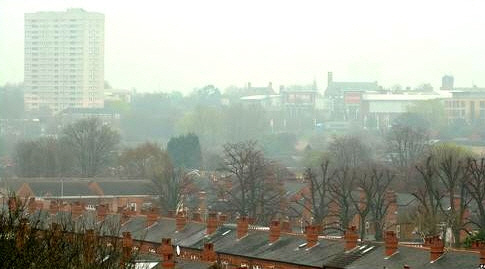SOLIHULL is considered one of 33 local authorities set to break legal limits on air pollution following a High Court case – and opposition councillors are demanding action.
Latest Public Health England figures – from 2014 – show 107 people were dying prematurely every year from air pollution in Solihull.
The UK government was ordered by the High Court at the end of February to ensure its air quality is brought to within legal limits following a case brought forward by environmental organisation Client Earth.
As a consequence, 33 local authorities were pinpointed as set to break legal limits of air pollution – of which one was Solihull council.
The case was based on data from the government’s Department for Environment, Food and Rural Affairs.
A directive was issued by DEFRA to Solihull council to take steps to bring air quality to within accepted levels.
DEFRA found there were three sites predicted to be exceeding the legal limits for the toxic gas, Nitrogen Dioxide (NO2).
Two were located in Shirley, on the Stratford Road, and the third was the junction between Damson Parkway and the Coventry Road.
According to more recent monitoring conducted by the Green Party, a fourth site near St Alphege School, has also been identified as breaching the limit.
Solihull council states it does not expect any of the sites to breach accepted NO2 limits by the end of the report, after UV corrections have been applied.
Solihull council brought the Air Quality Monitoring scheme it started in July last year to a scrutiny meeting last week.
Green councillors questioned why none of six months of collected data was revealed.
Green councillor Max McLoughlin said: “My role in opposition is to hold the administration to account.
“But when you’re given no information, you can’t do that. We’re measuring one toxic gas (NO2) that breaks down in the summer into another toxic gas that we aren’t even measuring (Ozone). The problem doesn’t disappear, we’re just not measuring it.
“When it’s something that’s killing 107 people in Solihull every year I want to know where the problems exist and what we’re doing to stop it. When we don’t even know the scale of the problem, we’re completely in the dark.”
Solihull council is the only local authority in the West Midlands not to have an Air Quality Management Area (AQMA) across its whole district.
This is despite the West Midlands having the worst air pollution outside London.
Solihull council says it is awaiting results to instate Air Quality Management Areas based on whether certain areas exceed the legal limits.
A council spokesperson said: “A full 12 months’ worth of data is needed to allow for fluctuations such as UV (ultra-violet) and wind speed, and to allow other correction factors to be applied.
“Historically Solihull council did measure air quality, however no exceedances of the Air Quality Objectives were shown, and consequently have not been declared within Solihull.
“DEFRA state that if a local authority finds any places where the air quality objectives are not likely to be achieved, it must declare an Air Quality Management Area there. We will make a decision as to whether to declare an AQMA once results of the current monitoring programme have been validated.
“We are working with the Joint Air Quality Unit to develop a Targeted Feasibility Study to identify measures that could bring forward compliance dates with the relevant statutory NO2 limit within the shortest possible time, on the Solihull road links identified in DEFRA’s national modelling.
“The Targeted Feasibility Study will be completed by the deadline of July 31 at the very latest.
“Solihull is about to commence a more comprehensive monitoring programme which will include particulate matter like Ozone.”
However, Coun McLoughlin pointed out that when NO2 is exposed to sunlight it breaks down into another toxic gas, ozone (O3).
The 2010 Marmot Report predicted an increase in summer respiratory problems, alongside increased skin cancers and cataracts because of ozone.
The Royal College of Physicians estimated that 40,000 deaths across the UK every year are caused by air pollution, almost double those killed by alcohol consumption.
Nitrogen dioxide is responsible for respiratory problems and can cause premature death.











